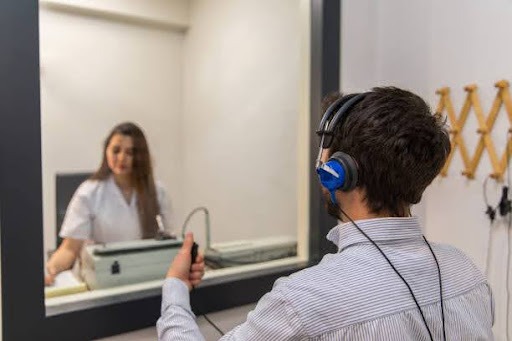BERA (Brain stem Evoked Response Audiometry)

BERA (Brain stem Evoked Response Audiometry)
BERA is an instrumental tool in diagnosing hearing impairments, particularly in infants and those who may face challenges during standard hearing tests. Its main function is to measure electrical activity generated by sound stimuli, providing an objective assessment of auditory nerve and brainstem functionality. Newborns or individuals with developmental challenges can have their hearing issues identified using this non-invasive test. BERA helps diagnose hearing loss type, degree, and site of impairment. The precise localization and characterization of hearing deficits play a critical role in tailoring suitable intervention strategies, such as medical, surgical, or rehabilitative options, thereby enabling early and targeted treatments. BERA is a valuable tool in monitoring auditory system disorders and intervention effectiveness, making significant contributions to comprehensive audiologic evaluations and hearing condition management.

FAQ
At Aanchal Hearing Care, our audiologists specialize in the assessment, diagnosis, and rehabilitation of hearing and balance disorders for all age groups.
We help you hear and communicate better, improving your overall quality of life.
Apart from routine audiological assessment, we have our specialists focusing on evaluation of tinnitus and they also provide tinnitus rehabilitation.
If you find yourself having difficulty in hearing — as in turning up the TV volume, missing out on conversations, experiencing ear ringing (tinnitus), dizziness or ear blockage — it’s time to book a consultation with us.
If you are an existing HA (hearing aid) user, if you require tuning (programming)/resetting of your hearing aid, battery or other accessories, also you can visit our clinic.
No referral is required — you can directly book an appointment with us. You can contact on the booking number: ________ & secure yourself a slot.
Online appointments are also available to reduce waiting time.
Our comprehensive hearing assessment includes an ear examination, pure tone audiometry, and speech testing to identify the type and degree of hearing loss.
Immittance evaluation & reflexometry could also be done to evaluate if you are having any infections or to understand middle ear status.
A typical hearing evaluation takes 30–45 minutes.
No. All the procedures are completely safe and painless.
Yes. We conduct pediatric hearing evaluations using child-friendly methods for infants, toddlers, and school-aged children.
After evaluating your test results, our audiologist will recommend whether hearing aids can benefit you, based on your hearing profile and lifestyle needs.
We offer the latest digital hearing aids, including Behind The Ear (BTE), Receiver In Canal (RIC), and Completely In Canal (CIC) models.
We also offer In The Canal (ITC) and Invisible In Canal (IIC) models too — both in battery and rechargeable segments — all from trusted global brands.
Yes! Aanchal Hearing Care offers trial fittings, allowing you to experience sound clarity before making a decision.
Hearing aids don’t restore natural hearing, but they amplify sounds precisely to help you hear more normally.
Hearing aids don’t restore natural hearing, but they amplify sounds precisely to help you hear more normally.
Yes. Aanchal Hearing Care offers 2 years of warranty for all hearing aids, and 2+ years of warranty for selected models.
Aanchal Hearing Care offers a wide range of hearing aid models of varying price ranges — from low-budget hearing aids to premium options.
Yes. At Aanchal Hearing Care, we strive to provide high-quality hearing aids at affordable rates.
We also offer EMI services to those in need.
Yes. Aanchal Hearing Care provides options for home visits to those in need of hearing tests and hearing aid fitting — within selected distance parameters (subject to location and availability).We also offer EMI services to those in need.
Sudden hearing loss is a medical emergency. Contact Aanchal Hearing Care or an ENT specialist immediately for urgent evaluation.
We recommend an annual hearing test for adults, or sooner if you notice any changes in hearing.
Tinnitus is a ringing, buzzing, or hissing sound in the ears without any external source. It’s often linked to hearing loss or noise exposure.
While tinnitus may not always be cured, our audiologists can help manage it effectively using sound therapy, counseling, and tinnitus management programs.
Yes. We offer vestibular assessments to identify and treat inner-ear-related balance problems such as vertigo or unsteadiness.
Clean them daily with a dry cloth, keep them in a moisture-free case, and make use of a dry kit.
Schedule routine servicing at our clinic to maintain performance.
Causes include aging, noise exposure, ear infections, genetic factors, medications, and sudden trauma.
Yes. Based on the cause, treatment may include medical management, hearing aids, or rehabilitative therapy.
Yes. Due to increased headphone use and loud environments, hearing loss in teens and young adults is rising
Yes, we provide the latest rechargeable and Bluetooth-enabled digital hearing aids for convenience and better connectivity.
It usually takes about 2 weeks of regular use to fully adjust. We guide you through every step during the adaptation phase.
